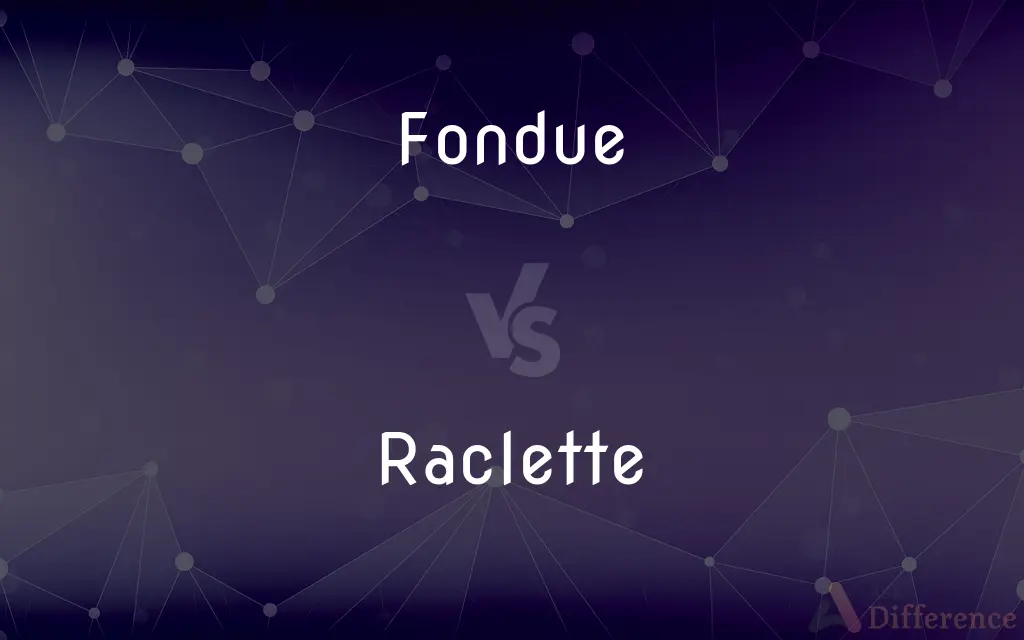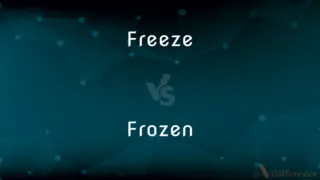Fondue vs. Raclette — What's the Difference?
Edited by Tayyaba Rehman — By Urooj Arif — Updated on April 8, 2024
Fondue involves melting cheese in a communal pot and dipping foods into it, while raclette features melting cheese on a grill or wheel and scraping it onto foods.

Difference Between Fondue and Raclette
Table of Contents
ADVERTISEMENT
Key Differences
Fondue is a dish of melted cheese served in a communal pot over a portable stove, eaten by dipping bread or other foods into the cheese using long-stemmed forks. On the other hand, raclette is a semi-hard cheese that is heated, either on a special grill or by the side of a fire, and then scraped off onto plates of food like potatoes, meats, and vegetables.
Originating from Switzerland, fondue became popular as a means to use up hardened cheese and bread during the winter. Whereas raclette, also Swiss, has its origins in the practice of Alpine herdsmen melting the cheese by the fire and scraping it onto their meals.
Fondue is traditionally made with cheeses like Gruyère and Emmental, combined with wine and garlic for flavor. In contrast, raclette is the name of both the dish and the type of cheese used, which melts well and has a distinctive, slightly nutty flavor.
The social aspect of both dishes is significant, with fondue providing an intimate experience as diners gather around a single pot. Raclette, meanwhile, allows for a more individualized experience, as diners can select and melt their own cheese, accompanied by a variety of sides.
In terms of equipment, fondue requires a fondue pot and long forks for dipping, emphasizing the communal aspect of sharing. Raclette, however, needs a raclette grill or a special heater to melt the cheese, focusing on individual plates and personal choice in toppings.
ADVERTISEMENT
Comparison Chart
Main Ingredient
Cheese melted in a communal pot
Cheese melted individually on a grill or wheel
Serving Method
Dipping foods into cheese using long-stemmed forks
Scraping melted cheese onto foods
Origin
Switzerland, for using up hardened cheese and bread
Swiss Alps, from herdsmen melting cheese by the fire
Cheese Types
Gruyère, Emmental, mixed with wine and garlic
Raclette cheese, known for its melting qualities
Social Aspect
Communal and intimate, gathered around one pot
Individualized, with personal choice in toppings
Equipment
Fondue pot and forks
Raclette grill or special heater
Compare with Definitions
Fondue
Served in a pot over heat.
Keep the fondue warm over a small flame to prevent it from hardening.
Raclette
A Swiss dish ideal for social gatherings.
Our family gatherings are incomplete without raclette.
Fondue
A dish of melted cheese for dipping.
We enjoyed a fondue with various dips like bread and apples.
Raclette
Involves personal choice in toppings.
The beauty of raclette lies in the variety of toppings you can choose from.
Fondue
Originates from Switzerland.
Fondue is a traditional Swiss dish that has gained international popularity.
Raclette
Accompanied by sides.
Traditional raclette is served with sides like pickles and onions.
Fondue
Involves dipping foods.
Long-stemmed forks are perfect for dipping into the fondue pot.
Raclette
A semi-hard cheese melted and scraped onto food.
We had raclette cheese melted over potatoes and vegetables.
Fondue
Communal eating experience.
Fondue nights are our favorite way to spend time with friends.
Raclette
Served by melting individual portions.
Each person can melt their raclette cheese according to their preference.
Fondue
Fondue (UK: , US: , French: [fɔ̃dy]) is a Swiss melted cheese dish served in a communal pot (caquelon or fondue pot) over a portable stove (réchaud) heated with a candle or spirit lamp, and eaten by dipping bread into the cheese using long-stemmed forks. It was promoted as a Swiss national dish by the Swiss Cheese Union (Schweizerische Käseunion) in the 1930s, and was popularized in North America in the 1960s.
Raclette
A Swiss dish consisting of cheese melted and served on boiled potatoes or bread.
Fondue
A hot dish made of melted cheese and wine and eaten with bread.
Raclette
Raclette (, French: [ʁaklɛt]) is a Swiss dish, also popular in France, based on heating cheese and scraping off the melted part. Raclette cheese is a Swiss cheese marketed specifically to be used for this dish.
Fondue
A similar dish, especially one consisting of a melted sauce in which pieces of food, such as bread, meat, or fruit, are dipped or cooked
Chocolate fondue.
Raclette
A firm cheese used in making this dish.
Fondue
A soufflé usually made with cheese and bread crumbs.
Raclette
A dish, of Swiss origin, similar to a fondue, consisting of melted cheese traditionally served on boiled potatoes and accompanied with pickles.
Fondue
A dish made of melted cheese, chocolate etc., or of a boiling liquid into which food can be dipped.
A Swiss fondue
Raclette
A firm cheese suitable for use in this dish.
Fondue
To prepare or serve as a fondue.
Fondue
A dish made of cheese, eggs, butter, etc., often seasoned with kirsch and white wine, melted together, and usually used as a dip for pieces of bread.
Fondue
A dish consisting of pieces of solid food cooked in or dipped into a hot sauce; as, beef fondue.
Fondue
Melted.
Fondue
Cubes of meat or seafood cooked in hot oil and then dipped in any of various sauces
Fondue
Hot sauce-like melted cheese or chocolate in which bread or fruits are dipped
Common Curiosities
How is raclette different from fondue?
Raclette involves melting individual portions of cheese on a grill or wheel and scraping it onto foods, unlike fondue, which is shared from a communal pot.
What type of cheese is raclette?
Raclette is both the name of the dish and the specific type of semi-hard Swiss cheese used in it, known for its excellent melting qualities.
What is fondue?
Fondue is a communal dish of melted cheese, served in a pot and eaten by dipping bread or other foods into it.
Is special equipment needed for fondue and raclette?
Yes, fondue requires a pot and long forks, while raclette needs a special grill or heater.
What are typical sides for raclette?
Common sides include small potatoes, pickles, onions, and sometimes meats.
How did fondue and raclette originate?
Both originated in Switzerland, with fondue as a way to use up hardened cheese and bread, and raclette from herdsmen melting cheese by the fire.
Can any cheese be used for fondue?
While various cheeses can be used, fondue traditionally features Swiss cheeses like Gruyère and Emmental.
Are there any variations of fondue besides cheese?
Yes, fondue can also refer to dishes where food is dipped into hot oil or chocolate, not just cheese.
Can raclette be considered a social dish like fondue?
Yes, both dishes are social and ideal for gatherings, though raclette offers a more individualized experience with personal choice in toppings.
Is it necessary to have a raclette grill to enjoy raclette?
While a raclette grill enhances the experience by allowing individual cheese melting, improvisation with other heating methods is possible.
Share Your Discovery

Previous Comparison
Livelihood vs. Sustenance
Next Comparison
Freeze vs. FrozenAuthor Spotlight
Written by
Urooj ArifUrooj is a skilled content writer at Ask Difference, known for her exceptional ability to simplify complex topics into engaging and informative content. With a passion for research and a flair for clear, concise writing, she consistently delivers articles that resonate with our diverse audience.
Edited by
Tayyaba RehmanTayyaba Rehman is a distinguished writer, currently serving as a primary contributor to askdifference.com. As a researcher in semantics and etymology, Tayyaba's passion for the complexity of languages and their distinctions has found a perfect home on the platform. Tayyaba delves into the intricacies of language, distinguishing between commonly confused words and phrases, thereby providing clarity for readers worldwide.














































